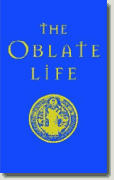The Oblate Life
Gervase Holdaway
book reviews:
· general fiction
· chick lit/romance
· sci-fi/fantasy
· graphic novels
· nonfiction
· audio books
· author interviews
· children's books @
curledupkids.com
· DVD reviews @
curledupdvd.com
newsletter
win books
buy online
links
home
for authors
& publishers
for reviewers

 |
The Oblate Life: A Handbook for Spiritual Formation Gervase Holdaway Liturgical Press Hardcover 328 pages September 2008 |
|
Fr. Gervase Holdaway, O.S.B., of Douai Abbey in England edited this collection of essays on the Benedictine Oblate life, a wonderful companion to The Benedictine Handbook also published by Liturgical Press in August 2003.
The Oblate Life Many of the essayists from various countries and backgrounds collected here are themselves oblates who can relate to their fellows or those new to the Benedictine oblate way of life. This book is divided into three parts: The Benedictine world, Living the Oblate life, and Resources for oblates. Parts one and two are subdivided into sections, which are further subdivided into chapters. The first section is on St. Benedict and introductory material on Benedictine history and what oblates are. The second section addresses discerning if one is called to be an oblate. Kathleen Norris is one of the essayists here and the noted author of The Cloister Walk. The third section covers what oblates are about. The foundation or basis of oblate life is Psalms and the Opus Dei, or divine office. Benedictine meditation is discussed by Fr. Luke Dysinger a monk in California. The method called Lectio Divina is an ancient Christian method of praying with the Scriptures, writings of the Fathers of the Church, writings of saints, with other writings or even with nature. Lectio Divina can be done alone or as a group. The fourth section on Benedictine spirituality includes essays on stability, obedience, moderation, and hospitality. Fr. Michael Casey, a monk from Australia, writes on moderation; Sr. Maria Boulding, an English nun, writes on obedience. The Anglican Archbishop of Canterbury, England, Rowan Williams, writes on how to live a holy life. In the fifth section, the authors write about oblates and the world - cyberspace, work, and helping their monasteries. Esther de Waal, an Anglican oblate who is the noted author of Seeking God, writes on creation. The sixth section discusses how oblates can be involved in the local parish or religious community. The seventh section contains several chapters on how to actually live as oblates in one’s own home, covering family life, marriage, the single life, health and sickness, leisure, death, and possessions. The final section lists the essayists with accompanying short biographies, as well as a list of select monasteries with oblate programs in most English-speaking countries. A bibliography is followed by a list of Internet websites, an explanation of the medal of St. Benedict, and a glossary of Benedictine terms with short definitions - a great help to those who are not already familiar with Benedictines. The Abbot Primate and symbolic head of the Benedictines, Notker Wolf, O.S.B., provides the foreword. A great resource for both long-time oblates and novices to oblate life, this book could also be informative to those interested in Benedictine spirituality or monasticism. Its many authors who are oblates provide information and reflections on what oblates are and what they can do by themselves, with a group, or with their monastery. In many ways, it is oblates communicating to oblates. The genesis for this book lies in the 2005 Oblate Congress held in Rome (there will be another in 2009). The Oblate Life Originally published on Curled Up With A Good Book at www.curledup.com. © Br. Benet Exton, O.S.B., 2008 |
|
|
|
 Click here to learn more about this month's sponsor! |
|
| fiction · sf/f · comic books · nonfiction · audio newsletter · free book contest · buy books online review index · links · · authors & publishers reviewers |
|
| site by ELBO Computing Resources, Inc. | |
 Oblates are laymen and women who attach themselves to a Benedictine, Trappist or Cistercian monastery, usually one near their home; sometimes it is a particular monastery with which they have come into contact. Catholics and non-Catholics can be oblates, making them an ecumenical group. Although oblates do not take the same vows as monks or nuns, they do promise to follow and live the Rule of St. Benedict as best they can in their secular life. Most have jobs and families, while others are retired or living alone. Oblates try to visit their monastery at least once or twice a year. Some spend a great deal of time with their monasteries, helping the monks or nuns in various capacities. Some monasteries call oblates associates, especially the Trappists.
Oblates are laymen and women who attach themselves to a Benedictine, Trappist or Cistercian monastery, usually one near their home; sometimes it is a particular monastery with which they have come into contact. Catholics and non-Catholics can be oblates, making them an ecumenical group. Although oblates do not take the same vows as monks or nuns, they do promise to follow and live the Rule of St. Benedict as best they can in their secular life. Most have jobs and families, while others are retired or living alone. Oblates try to visit their monastery at least once or twice a year. Some spend a great deal of time with their monasteries, helping the monks or nuns in various capacities. Some monasteries call oblates associates, especially the Trappists.